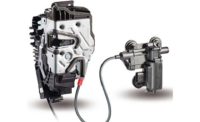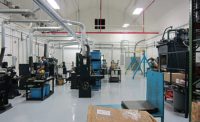Fitzpatrick Manufacturing, a CNC machine shop and custom manufacturer founded in 1952, supplies parts to more than a dozen sectors, including aerospace, automotive, medical equipment and oil and gas. To increase operational efficiency and improve part quality, Fitzpatrick Manufacturing adopted a Sawyer collaborative robot from Rethink Robotics.
Sawyer is helping Fitzpatrick hone parts that become components for the motion control industry. But as the Sterling Heights, MI-based company’s jobs get bigger, it’s harder to find people willing to do the work.
“This machine tending application was mindless and tedious,” says Kevin LaComb, co-president at Fitzpatrick Manufacturing. “There were four people rotating on this job to prevent boredom. They’re just taking parts and loading them into the machine, checking the parts, washing them, and packaging them. They were under the impression they’d be a machine operator, but they’re on the most boring job ever.”
This boredom lead to quality control issues. Fitzpatrick’s customers would report that some of the pieces were shipped without being cleaned or that parts were packaged upside-down—errors attributed to the human workers. Sawyer eliminated these errors and guarantees every part in the box is 100 percent correct.
Sawyer is able to identify, load and remove parts from the honing machine. It then washes, dries and packages the finished product. With 400 spots on the pin board to process, Sawyer can package between 280 and 300 parts before a human worker needs to intervene. From start to finish, this process takes five to eight hours.
Because of the limited need for human intervention, Fitzpatrick allows Sawyer to run overnight, lights-out and have all the parts ready to go when workers arrive back at the facility. Sawyer runs 24 hours a day Monday through Friday, which has shortened the timeline for Fitzpatrick’s return on investment from a year to eight months.
Thanks to Sawyer, Fitzpatrick is now producing, on average, 300 pieces more per day. Four employees have gone from standing in front of a machine for 10 hours every day to tending to Sawyer for just one hour per 1,000 pieces produced.
“A human out-produced Sawyer for the first two to three hours of the day, but after that things slow down,” says LaComb. “Robots don’t take a bathroom break, lunch break or a coffee break. Humans now just make sure Sawyer has parts. If it doesn’t, they load more into Sawyer and take boxes away.”
Jon Mutz, a team leader at Fitzpatrick Manufacturing, had no previous experience with robotics, but is now responsible for all the programming on Sawyer and only one of four people able to operate it.
“I’m a machinist. I could run a CNC machine and that’s it,” says Mutz. “The distributor got it up and running and I got a quick hands-on tutorial. Then I jumped on Rethink’s website and went through the training portal, which was extremely helpful. After about two weeks, it became extremely easy to use.”
Given the success Fitzpatrick Manufacturing is already having with Sawyer, they are looking to bring automation to different parts of the operation in the future. LaComb predicts there will be between three and five Sawyer robots in the company’s packaging area within the next two years.
“A big part of this experiment is seeing if we can have Sawyer in our packaging area building kits. We’re already making 17 of a customer’s 25 components, so we’re starting to receive requests to build kits.”
Editor’s note: On Oct. 3, shortly before press time, Rethink Robotics closed. We opted to keep this item in the magazine as an example of how manufacturers are taking advantage of the intriguing new technology of collaborative robots. Cobots are available from a variety of mainstream robotics companies, including ABB, Comau, Fanuc, KUKA, Stäubli and Universal Robots.



